Evaluation of Safety in Horizontal Curves of Roads Using a Multi-Body Dynamic Simulation Process
Abstract
:1. Introduction
2. Methods and Materials
2.1. The Multi-Body Dynamic Simulation Process
2.2. Modeling
2.2.1. Circular Curve Modeling in ADAMS/Car
2.2.2. Clothoid Curve Modeling in ADAMS/Car
- Consider the McLaurin polynomials of a certain degree for sin(x) and cos(x).
- Replace the values of the integrated solution in Equations (6) and (7) in McLaurin polynomials at the point .
- Use Barrow’s rule to compute the result of integral.
2.2.3. Designed Parameters in Horizontal Curves
2.3. Vehicle Modeling
2.4. The Tire–Road Friction Modeling
3. Result and Discussion
3.1. Maximum Lateral and Longitudinal Frictions
3.2. Lateral Friction Demand
3.3. Effect of Longitudinal Profile on Safety Margin
3.4. Effect of Radius on the Minimum Safety Margin
- The difference between the minimum safety margin in circular and clothoid curves for heavy vehicles is greater than that of the sedan.
- The design of clothoid–circle–clothoid curves on the roads with a higher traffic volume of heavy vehicles leads to a greater safety margin for the vehicles.
- In low-radius curves, the difference in the safety margin of circular and clothoid is slight. Therefore, in lower radii, there is not a significant difference between circular and clothoid transition curves.
3.5. General Examination of the Safety Margin for Light and Heavy Vehicles
- On all selected grades, the difference between the values of the safety margin for heavy vehicles (bus and 3-axle truck) is much more than that of the sedan (about 37%). This difference is related to the condition in which the road surface is dry (AASHTO assumption), but if the road surface conditions change, such as due to rainfall, this difference in value could change.
- For the bus, the pattern of changes in the values of the safety margin parameter, in different radius and on the clothoid–circle–clothoid curves, is almost constant and similar to that of the 3-axle truck vehicle (see Figure 16a,c,e). However, in circular curves (see Figure 16b,d,f), this value decreases with an increasing curve radius from 252 to 560 m (about 14%).
- In all conditions, the pattern of the safety margin for the 3-axle truck is constant. More radius leads to more safety margin.
4. Validation
5. Conclusions
- The comparison of the values of safety margin in both curves indicates that the existence of the clothoid in curves with a low radius does not have a considerable impact on increasing safety margin. In contrast, in curves with a high radius, clothoid can improve the safety margin.
- For all vehicles and on the small radii, the safety margin values of both horizontal curves showed a small difference. However, by increasing the radius, the clothoid–circle–clothoid curve had better safety margin values than the simple circular curve, especially for heavy vehicles. As a result, it is a necessity to use a clothoid transition curve in the curves with a high radius. Albeit, in the case of high radii, the safety margin in both curves was nearly equal for the sedan.
- On simple circular curves, instantaneous changes in the safety margin are much greater than those in the clothoid–circle–clothoid curves. The reduction of the safety margin on the clothoid–circle–clothoid curves is much less than that on the simple circular curves.
- Most studies related to lateral friction factors have focused on simple circular curves, and there is no study related to the combination of horizontal and transition curves. In this study, the friction factors were applied to the clothoid–circle–clothoid system. These friction factors can be used as a control regulation of safety in geometric design for all combinations of curves. In fact, the proposed methodology can be applied for evaluating safety in any new form of curves that will be presented by engineers.
- The maximum lateral friction demand for simple circular curves indicate that the obtained friction demand for a sedan on low-radius curves does not significantly differ from those proposed by AASHTO. However, for heavy vehicles (bus and 3-axle truck), the maximum lateral friction factor showed more critical values for vehicle safety. Therefore, the designers must differentiate between light and heavy vehicles.
- According to the results, the maximum lateral friction factor decreases with the increasing radius in both horizontal curves.
- According to the maximum lateral friction factor for simulated longitudinal grades, a maximum reduction of 13.9% was observed in the maximum lateral friction for a sedan on a 951 m clothoid curve. The corresponding reductions to 560, 252, and 79 m curves were 7.49%, 0.78%, and 0.8%, respectively. The maximum reduction of the lateral friction factor on a 79, 252, and 560 m clothoid curve for the bus was respectively 5.5%, 23.8%, and 14% relative to a simple circular curve. The corresponding values for a 3-axle truck on the designed curves were 4.1%, 17%, and 19.7%, respectively. The comparison of these values indicates that the impact of the transition curve on heavy vehicles is more significant than that on light vehicles. As the final part of the paper, the authors have two attractive proposals for future studies. By more examination of the point-mass model, it can be found that the model has two other major challenging issues:
- In the point-mass model, vehicles are considered as a point mass. However, a vehicle has four tires (or more) that can have various behaviors. Therefore, a new proposal that authors have selected for their future studies is to analyze the behavior of various tires of design vehicles.
- The AASHTO green book assumes that superelevation is constant in simple circular curves. On the other hand, this standard proposes that a part of superelevation implementation distance occurs inside the curve. Therefore, the initial and final parts of the curves have different superelevation than the middle part. This issue can create safety challenges for vehicles, especially vehicles with long length. Therefore, another suggested proposal of the authors is related to superelevation in simple circular horizontal curves.
Author Contributions
Funding
Acknowledgments
Conflicts of Interest
References
- Abdi Kordani, A.; Mehrara Molan, A. The effect of combined horizontal curve and longitudinal grade on side friction factors. KSCE J. Civ. Eng. 2015, 19, 303–310. [Google Scholar] [CrossRef]
- Wang, P.; Rau, P.L.P.; Salvendy, G. Road safety research in China: Review and appraisal. Traffic Inj. Prev. 2010, 11, 425–432. [Google Scholar] [CrossRef]
- Dell’Acqua, G.; Busiello, M.; Russo, F. Safety data analysis to evaluate highway alignment consistency. Transp. Res. Rec. 2013, 2349, 121–128. [Google Scholar] [CrossRef]
- Kang, M.W.; Shariat, S.; Jha, M.K. New highway geometric design methods for minimizing vehicular fuel consumption and improving safety. Transp. Res. Part C Emerg. Technol. 2013, 31, 99–111. [Google Scholar] [CrossRef]
- Eftekharzadeh, S.F.; Khodabakhshi, A. Safety evaluation of highway geometric design criteria in horizontal curves at downgrades. Int. J. Civ. Eng. 2014, 12, 326–332. [Google Scholar]
- Yin, Y.; Wen, H.; Sun, L.; Hou, W. The Influence of Road Geometry on Vehicle Rollover and Skidding. Int. J. Environ. Res. Public Health 2020, 17, 1648. [Google Scholar] [CrossRef] [Green Version]
- Wang, B.; Hallmark, S.; Savolainen, P.; Dong, J. Crashes and near-crashes on horizontal curves along rural two-lane highways: Analysis of naturalistic driving data. J. Saf. Res. 2017, 63, 163–169. [Google Scholar] [CrossRef] [PubMed]
- Abdi Kordani, A.; Rahmani, O.; Abdollahzadeh Nasiri, A.S.; Boroomandrad, S.M. Effect of adverse weather conditions on vehicle braking distance of highways. Civ. Eng. J. 2018, 4, 46–57. [Google Scholar] [CrossRef] [Green Version]
- Intini, P.; Berloco, N.; Ranieri, V.; Colonna, P. Geometric and Operational Features of Horizontal Curves with Specific Regard to Skidding Proneness. Infrastructures 2020, 5, 3. [Google Scholar] [CrossRef] [Green Version]
- Geedipally, S.R.; Pratt, M.P.; Lord, D. Effects of geometry and pavement friction on horizontal curve crash frequency. J. Transp. Saf. Secur. 2019, 11, 167–188. [Google Scholar] [CrossRef]
- Bogenreif, C.; Souleyrette, R.R.; Hans, Z. Identifying and measuring horizontal curves and related effects on highway safety. J. Transp. Saf. Secur. 2012, 4, 179–192. [Google Scholar] [CrossRef]
- AASHTO. A policy on Geometric Design of Highways and Streets; American Association of State Highway and Transportation Officials: Washington, DC, USA, 2018. [Google Scholar]
- Colonna, P.; Berloco, N.; Intini, P.; Ranieri, V. The method of the friction diagram: New developments and possible applications. In Proceedings of the Transport Infrastructure and Systems: Proceedings of the AIIT International Congress on Transport Infrastructure and Systems, Rome, Italy, 10–12 April 2017; p. 309. [Google Scholar]
- Colonna, P.; Berloco, N.; Intini, P.; Perruccio, A.; Ranieri, V. Evaluating skidding risk of a road layout for all types of vehicles. Transp. Res. Rec. 2016, 2591, 94–102. [Google Scholar] [CrossRef]
- Donnell, E.; Wood, J.; Himes, S.; Torbic, D. Use of side friction in horizontal curve design: A margin of safety assessment. Transp. Res. Rec. 2016, 2588, 61–70. [Google Scholar] [CrossRef]
- Torbic, D.J.; O’Laughlin, M.K.; Harwood, D.W.; Bauer, K.M.; Bokenkroger, C.D.; Lucas, L.M.; Ronchetto, J.R.; Brennan, S.; Donnell, E.; Brown, A. ; Varunjikar,T. NCHRP 774 Report: Superelevation Criteria for Sharp Horizontal Curves on Steep Grades; The National Academie Press: Washington, DC, USA, 2014. [Google Scholar]
- Pratt, M.P.; Geedipally, S.R. Developing a framework for evaluating and selecting curve safety treatments. In Proceedings of the Transportation Research Board 95th Annual Meeting, Washington, DC, USA, 10–14 January 2016. [Google Scholar]
- Li, P.; He, J. Geometric design safety estimation based on tire–road side friction. Transp. Res. Part C Emerg. Technol. 2016, 63, 114–125. [Google Scholar] [CrossRef]
- Himes, S.C. Reliability Based Design of Horizontal Curves Considering the Effects of Grades. Ph.D. Thesis, The Pennsylvania State University, State College, PA, USA, May 2013. [Google Scholar]
- Zhang, Z.; Cheng, J. Safety Margin-Based Analysis on Road Superelevation Rate Selection. In Proceedings of the 15th COTA International Conference of Transportation Professionals (CICTP 2015), Beijing, China, July 24–27 2015; pp. 2386–2396. [Google Scholar]
- Varunjikar, T. Design of Horizontal Curves with Downgrades Using Low-Order Vehicle Dynamics Models. Masther’s Thesis, The Pennsylvania State University, State College, PA, USA, 11. Masther’s Thesis, The Pennsylvania State University, State College, PA, USA, 2011 May.
- Hon, Y.C.; Mao, X.Z. A multiquadric interpolation method for solving initial value problems. J. Sci. Comput. 1997, 12, 51–55. [Google Scholar] [CrossRef]
- Carlson, R.E.; Foley, T.A. The parameter R2 in multiquadric interpolation. Comput. Math. Appl. 1991, 21, 29–42. [Google Scholar] [CrossRef] [Green Version]
- Abramowitz, M.; Stegun, I.A. Handbook of Mathematical Functions with Formulas, Graphs, and Mathematical Tables; US Government Printing Office: Washington, DC, USA, 1948; Volume 55. [Google Scholar]
- Vázquez-Méndez, M.E.; Casal, G. The clothoid computation: A simple and efficient numerical algorithm. J. Surv. Eng. 2016, 142, 04016005. [Google Scholar] [CrossRef]
- ADAMS/Car; University of Michigan: Ann Arbor, MI, USA.
- Acosta, M.; Kanarachos, S.; Blundell, M. Road friction virtual sensing: A review of estimation techniques with emphasis on low excitation approaches. Appl. Sci. 2017, 7, 1230. [Google Scholar] [CrossRef] [Green Version]
- Pacejka, H. Tire and Vehicle Dynamics; Elsevier: New York, NY, USA, 2005. [Google Scholar]
- Kuiper, E.V.O.J.; Van Oosten, J.J.M. The PAC2002 advanced handling tire model. Veh. Syst. Dyn. 2007, 45, 153–167. [Google Scholar] [CrossRef]
- Li, L.; Song, J.; Li, H.Z.; Shan, D.S.; Kong, L.; Yang, C.C. Comprehensive prediction method of road friction for vehicle dynamics control. Proc. Inst. Mech. Eng. Part D J. Automob. Eng. 2009, 223, 987–1002. [Google Scholar] [CrossRef]
- Li, L.; Yang, K.; Jia, G.; Ran, X.; Song, J.; Han, Z.Q. Comprehensive tire–road friction coefficient estimation based on signal fusion method under complex maneuvering operations. Mech. Syst. Signal Process. 2015, 56, 259–276. [Google Scholar] [CrossRef]

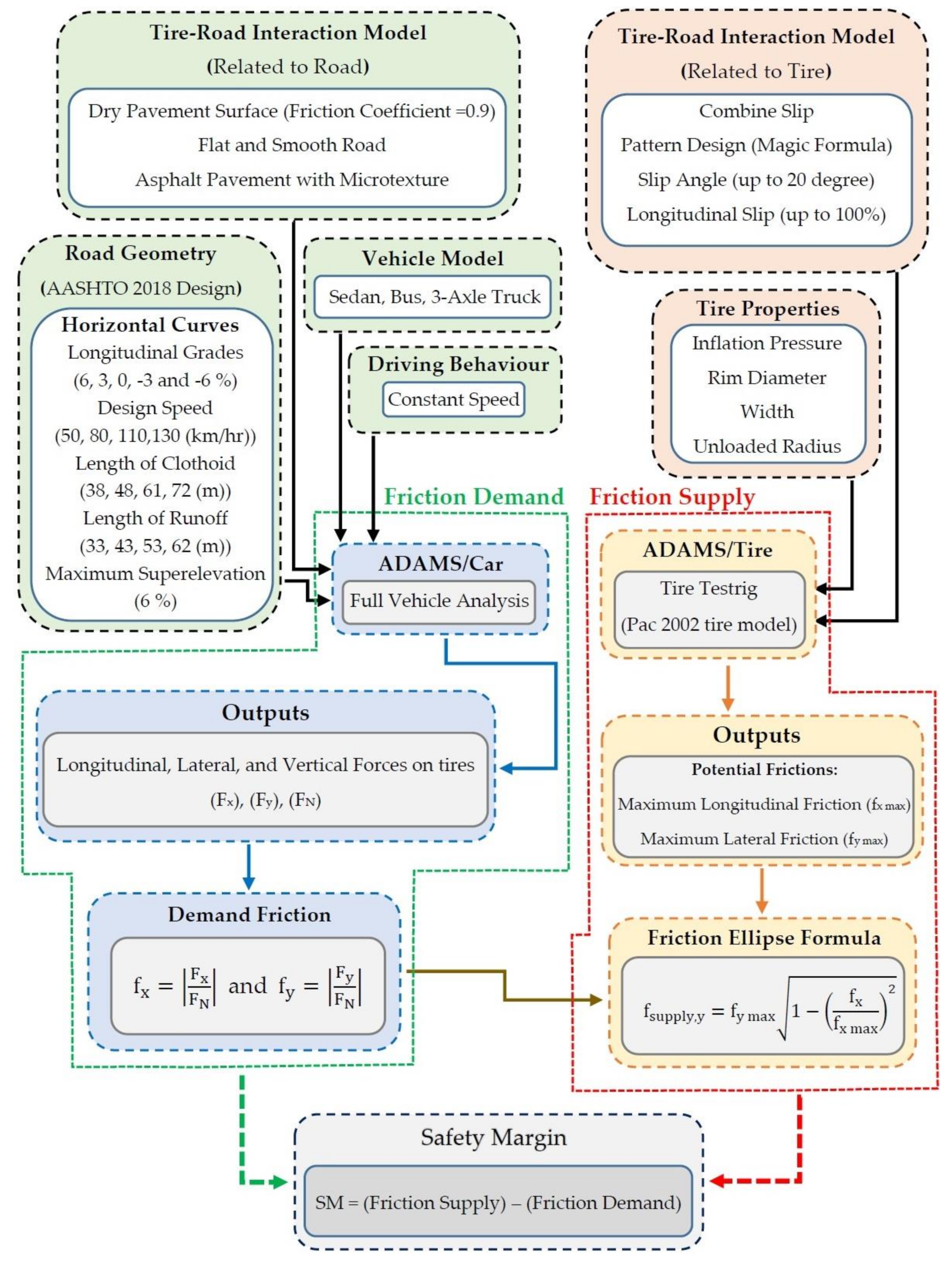
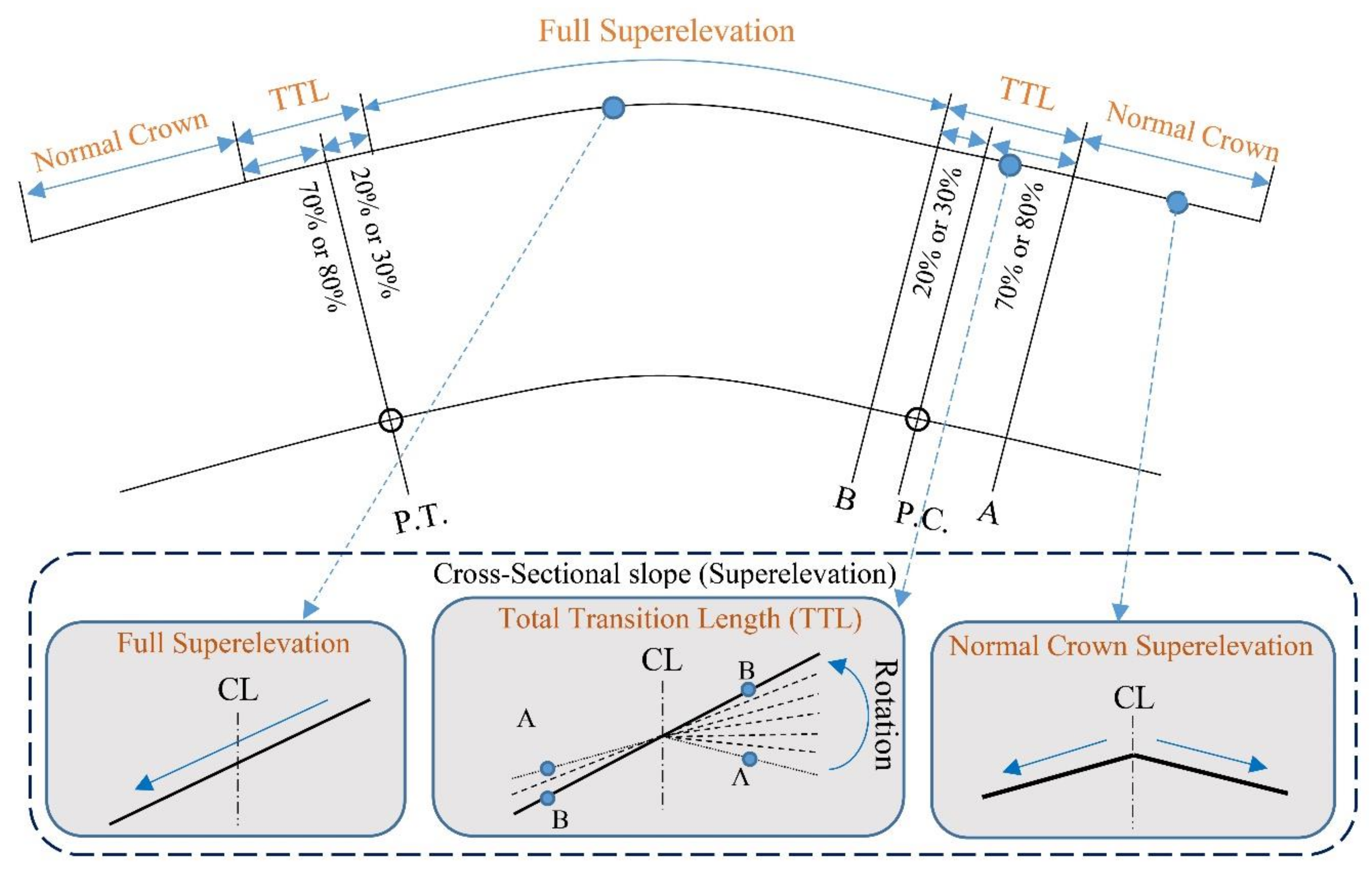
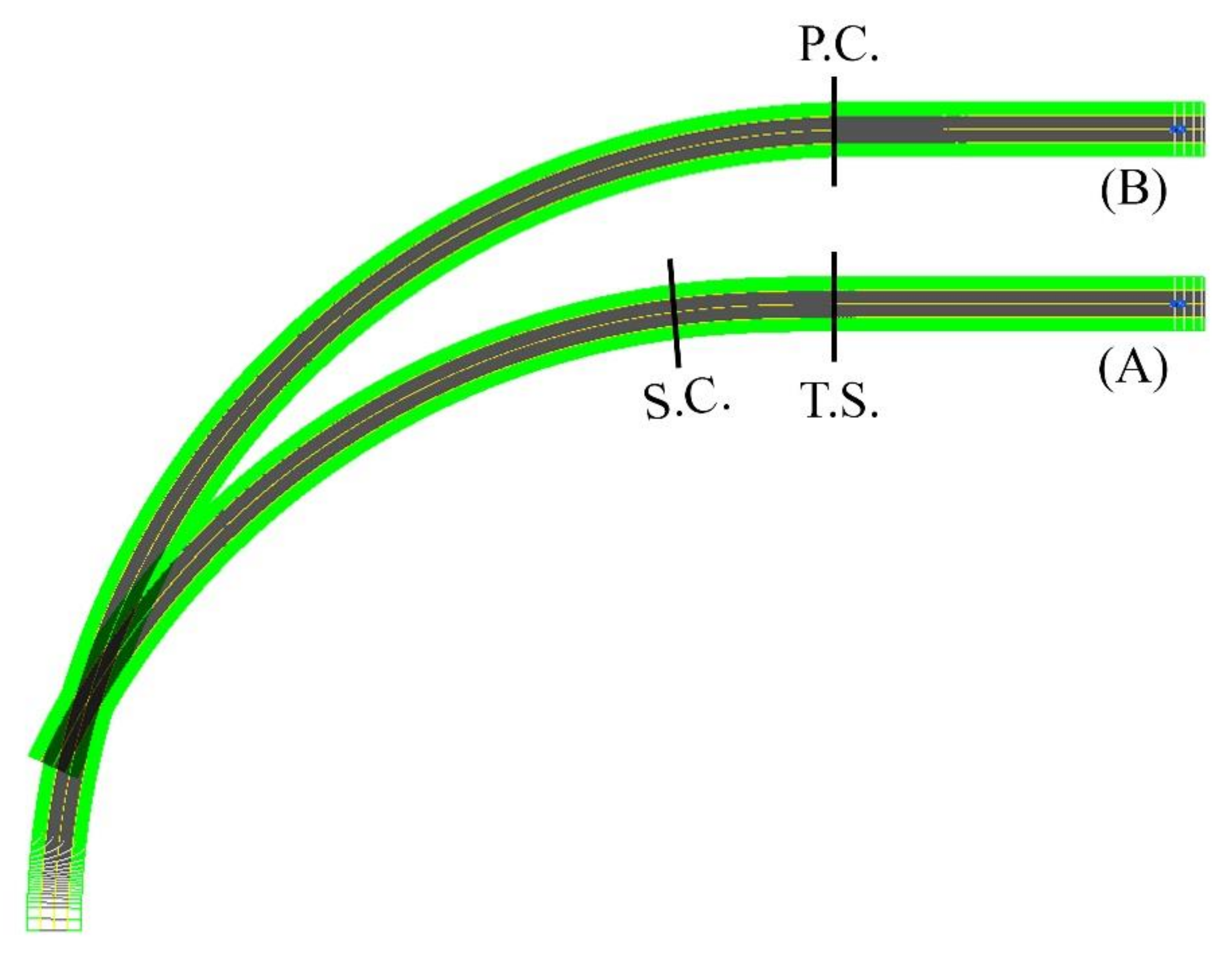
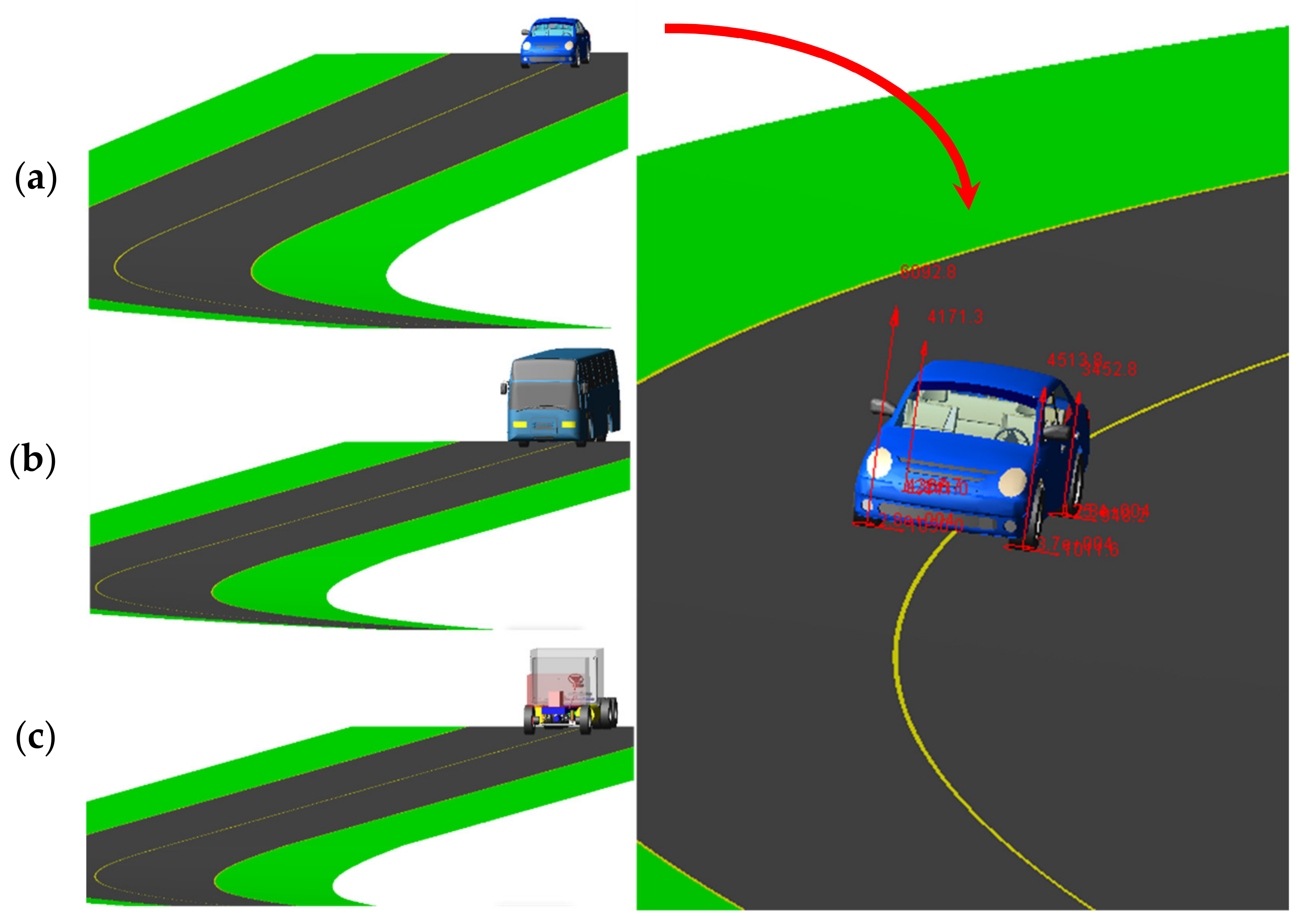



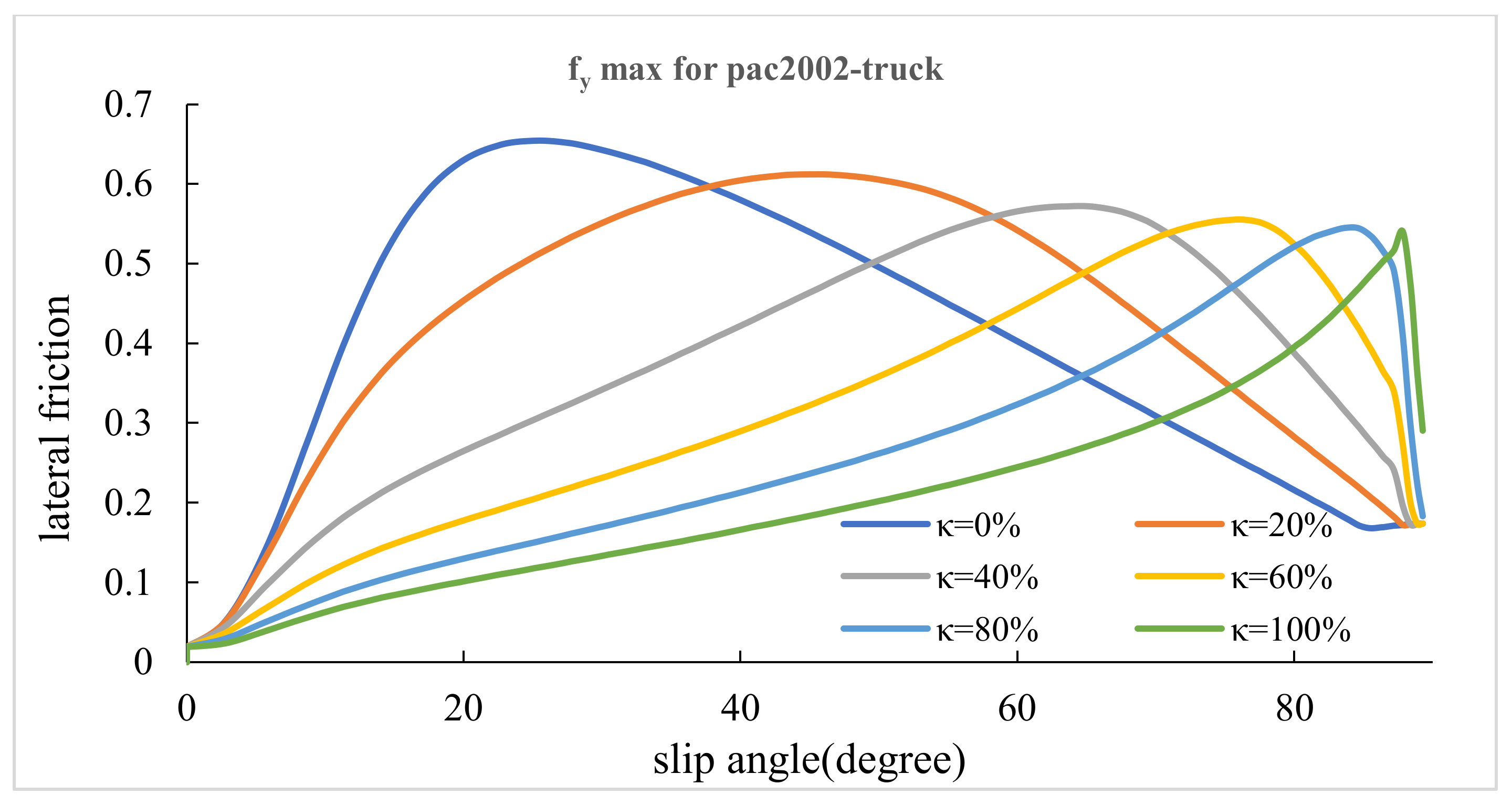
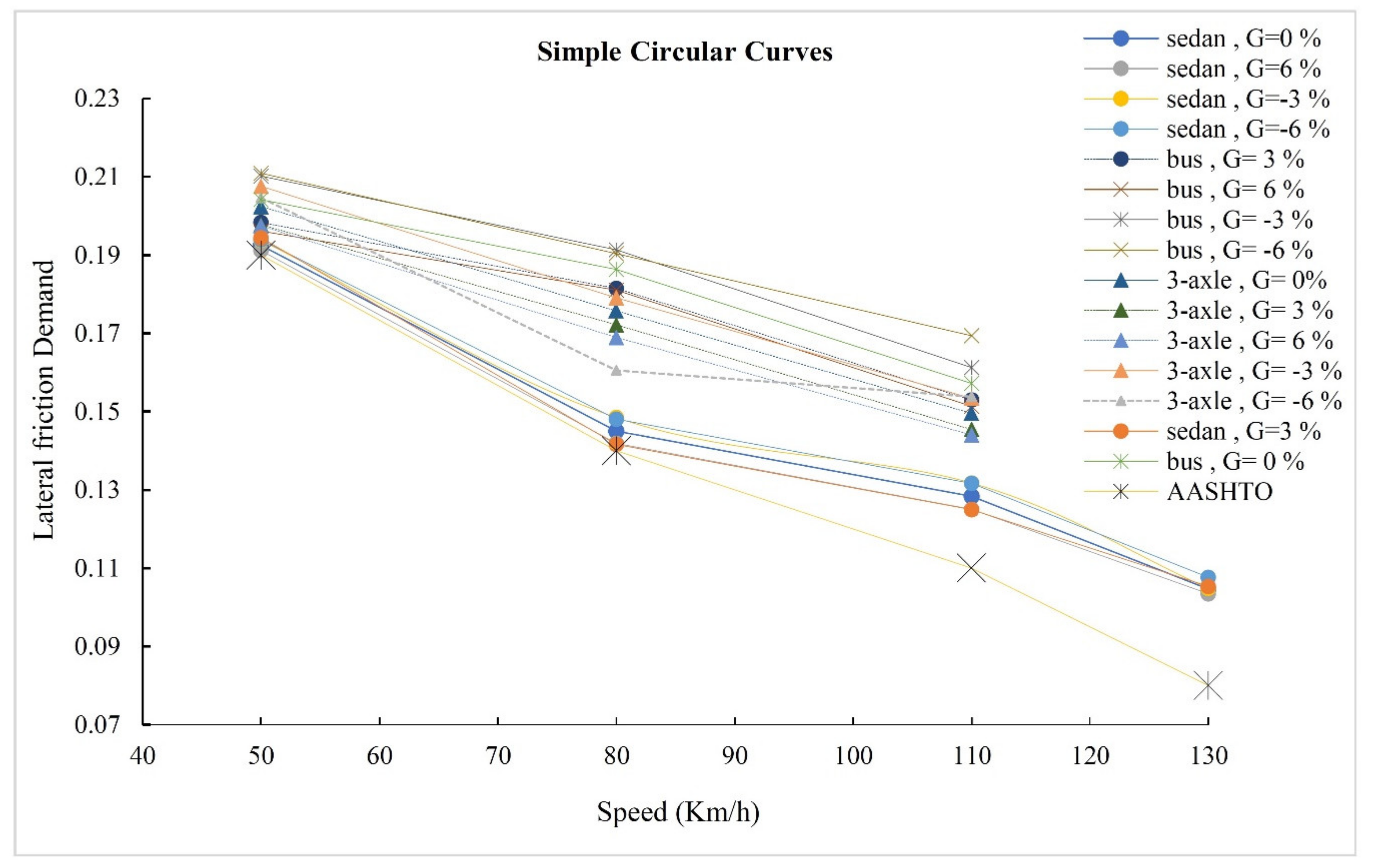
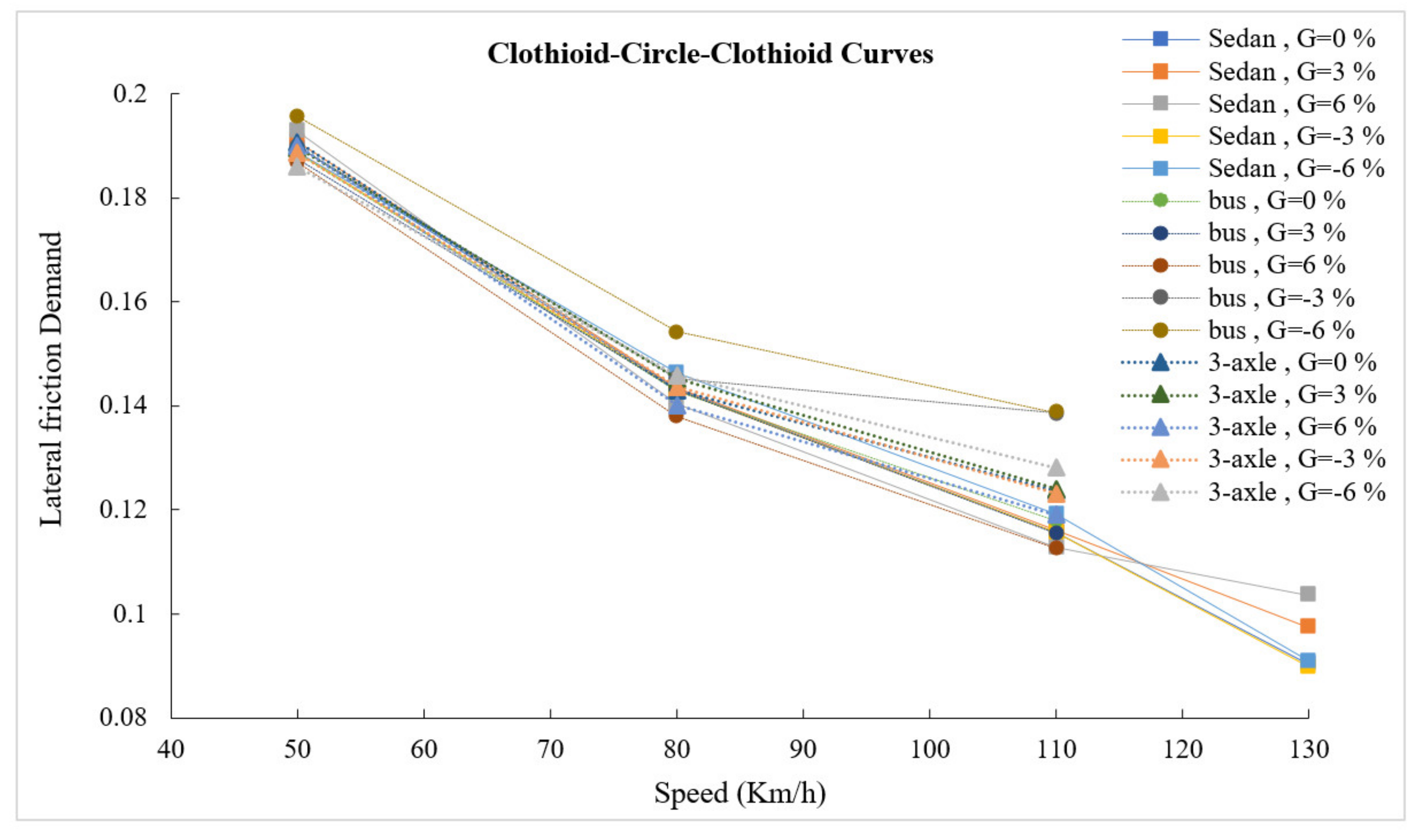

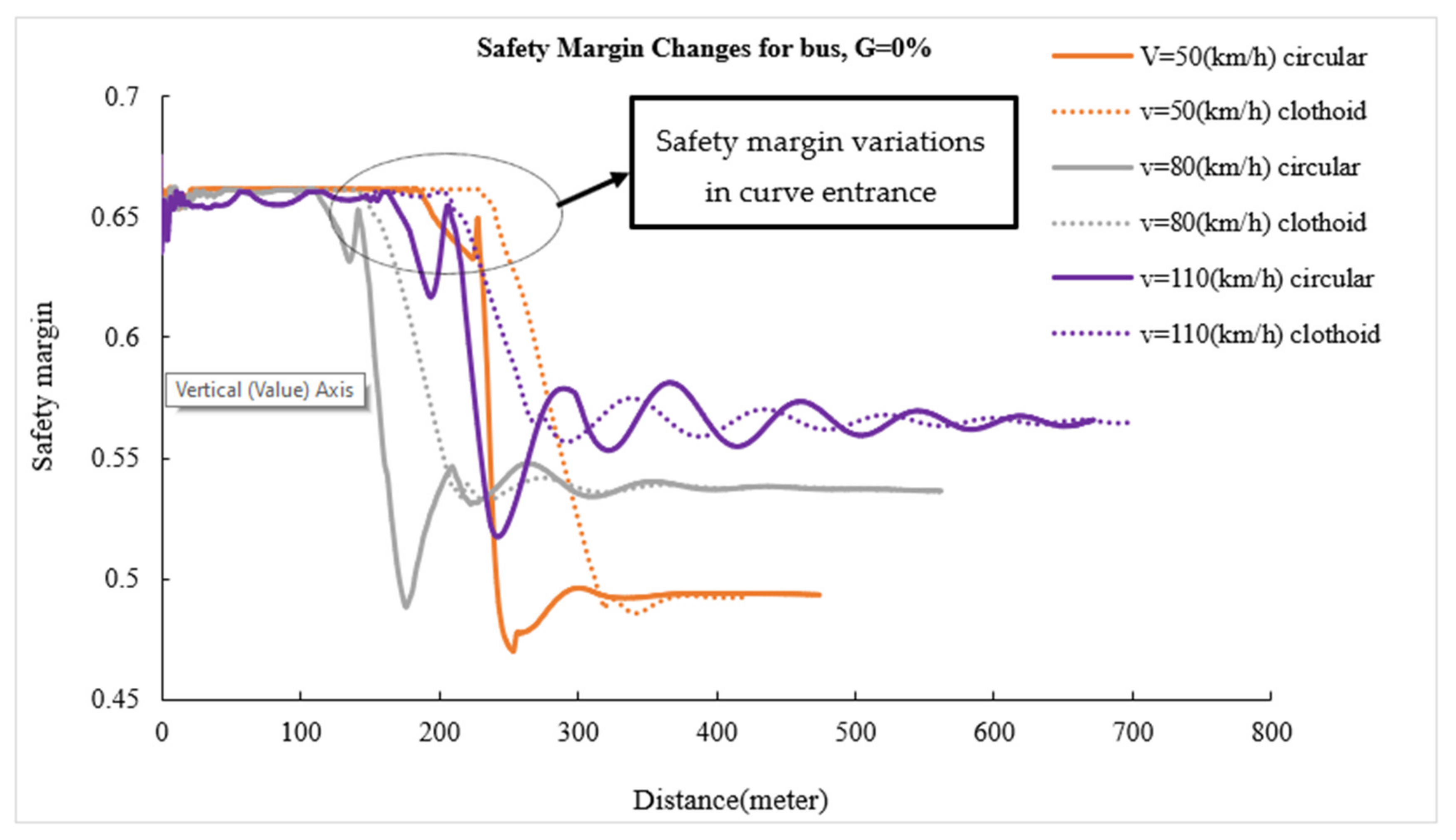
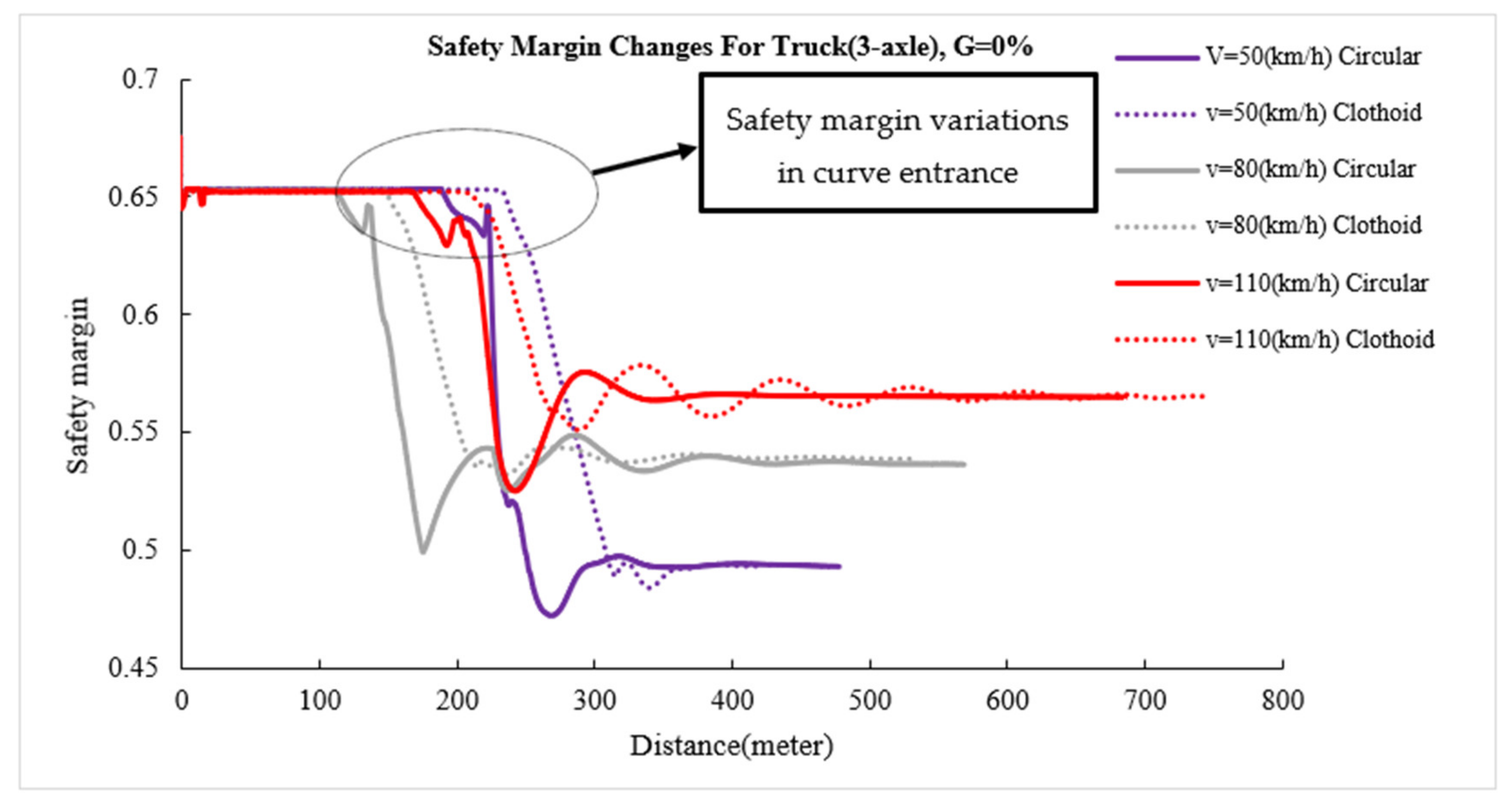
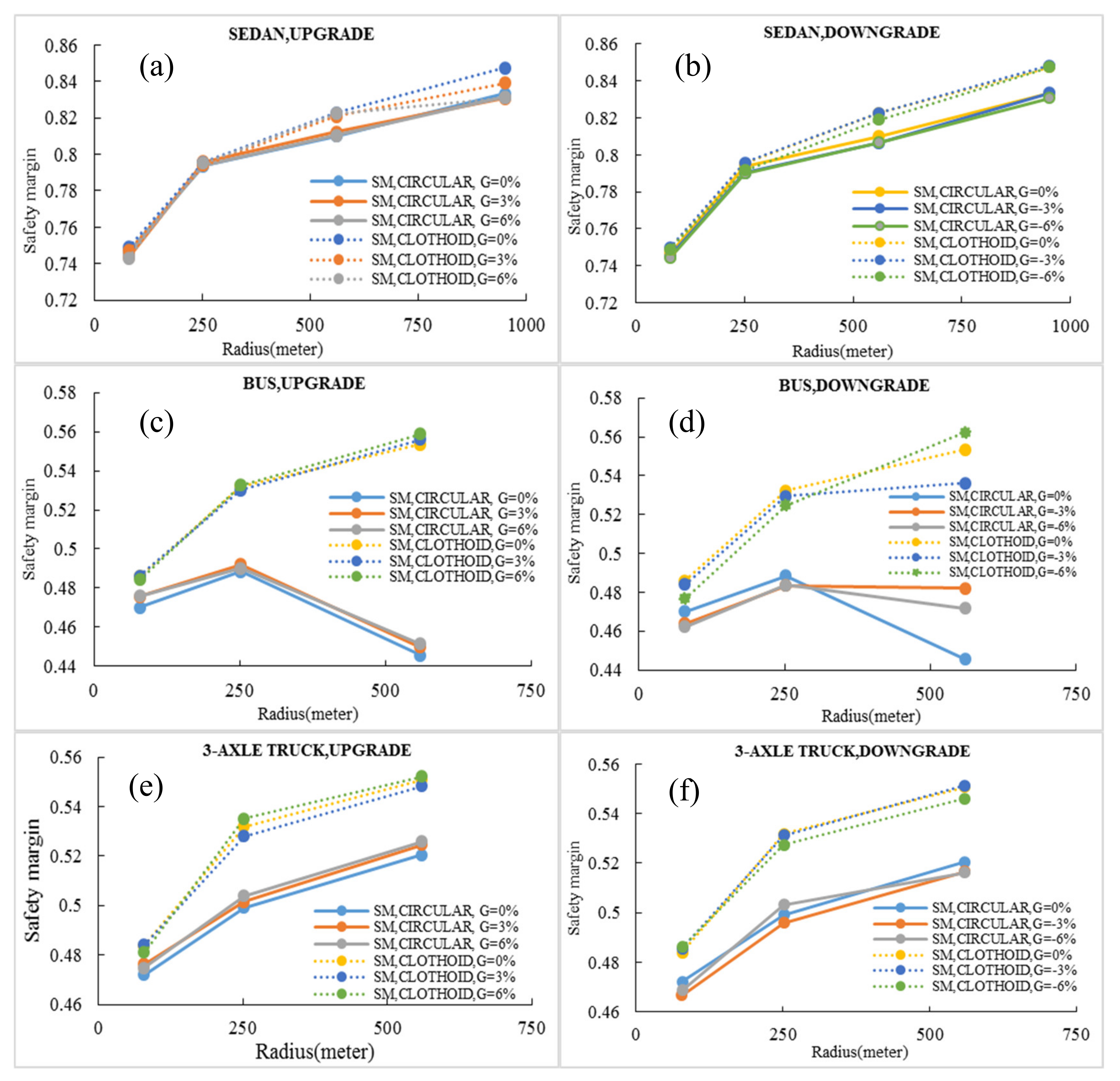

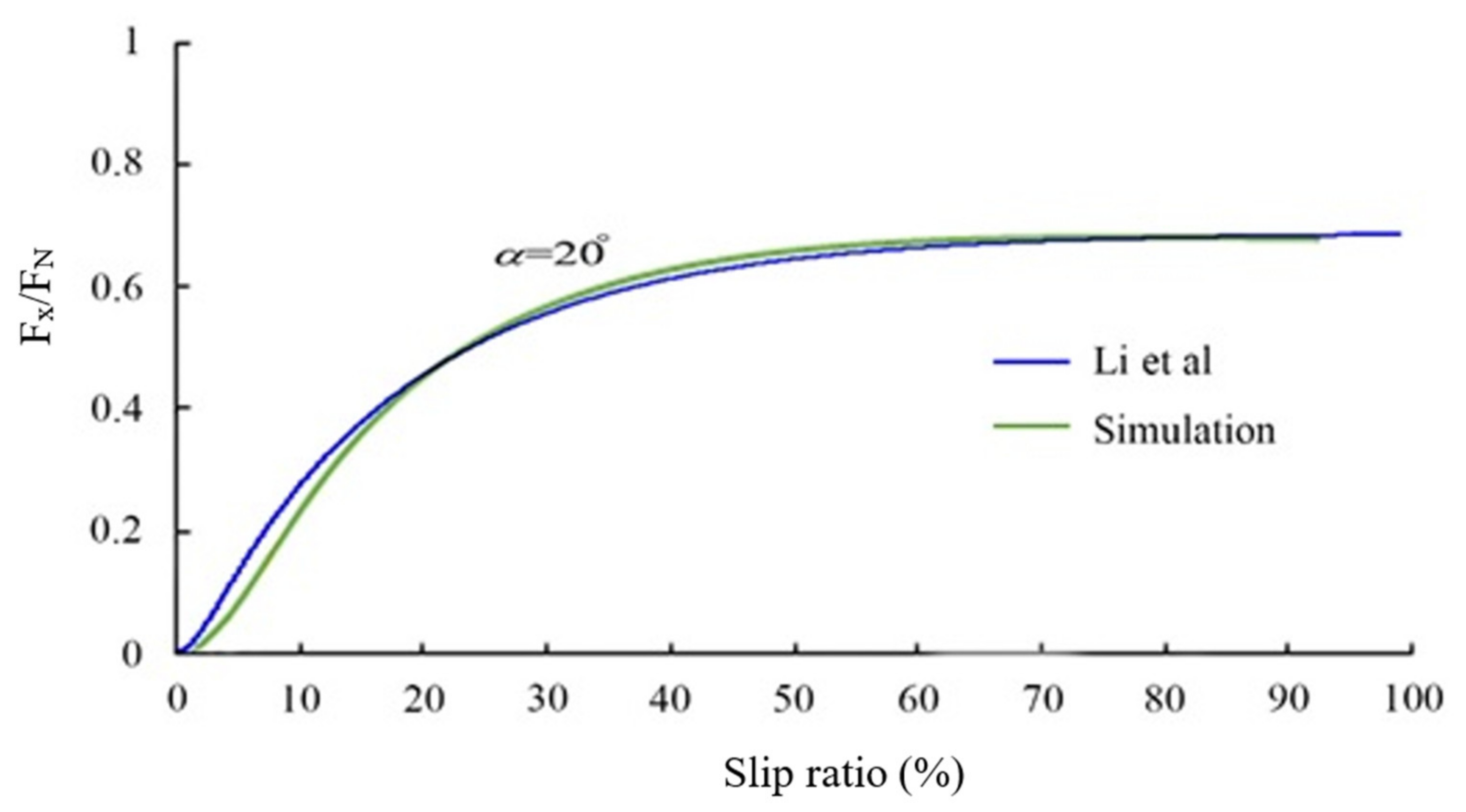

| Speed (km/h) | The Radius of the Circular Curve (m) | Length of Clothoid Curve (m) |
|---|---|---|
| 50 | 79 | 71 |
| 80 | 252 | 91 |
| 110 | 560 | 114 |
| 130 | 951 | 134 |
| Design Speed (km/h) | Superelevation (%) | Maximum Friction [12] | Total | Calculated Radius (m) | Rounded Radius (m) |
|---|---|---|---|---|---|
| 50 | 6 | 0.19 | 0.25 | 78.7 | 79 |
| 80 | 6 | 0.14 | 0.2 | 252.0 | 252 |
| 110 | 6 | 0.11 | 0.17 | 560.4 | 560 |
| 130 | 6 | 0.08 | 0.14 | 950.5 | 951 |
| Parameters in Simple Circular Curves | |||||||
|---|---|---|---|---|---|---|---|
| Speed (km/h) | Curve Radius (m) | Longitudinal Grade (%) | Superelevation (Degree) | Friction Coefficient of Road Surface | Road Width (m) | ||
| 50 | 79 | 6, 3, 0, −3, −6 | 3.42 | 0.9 | 3.65 | ||
| 80 | 252 | 6, 3, 0, −3, −6 | 3.42 | 0.9 | 3.65 | ||
| 110 | 560 | 6, 3, 0, −3, −6 | 3.42 | 0.9 | 3.65 | ||
| 130 | 951 | 6, 3, 0, −3, −6 | 3.42 | 0.9 | 3.65 | ||
| Parameters in Clothoid–Circle–Clothoid Curves | |||||||
| Speed (km/h) | Curve Radius (m) | Longitudinal Grade (%) | Superelevation (Degree) | Friction Coefficient of Road Surface | Road Width (m) | Length of Clothoid (m) | Length of Runoff (m) |
| 50 | 79 | 6, 3, 0, −3, −6 | 3.42 | 0.9 | 3.65 | 38 | 33 |
| 80 | 252 | 6, 3, 0, −3, −6 | 3.42 | 0.9 | 3.65 | 48 | 43 |
| 110 | 560 | 6, 3, 0, −3, −6 | 3.42 | 0.9 | 3.65 | 61 | 53 |
| 130 | 951 | 6, 3, 0, −3, −6 | 3.42 | 0.9 | 3.65 | 72 | 62 |
| Vehicle Type | Sedan | Bus | 3-Axle Truck | |
|---|---|---|---|---|
| Parameter | Length of wheel-base (mm) | 3076 | 10,268 | 8047 |
| Width (mm) | 1895 | 2483 | 2244 | |
| Height (mm) | 1500 | 3411 | 3132 | |
| Weight (kg) | 1980 | 11,697.1 | 10,844.3 | |
| Gravity Center from Ground (mm) | 450 | 1300 | 1163 | |
| Parameters | Tire | ||
|---|---|---|---|
| Sedan | Bus | 3-Axle Truck | |
| Type | pac2002-235-40R18 | pac2002-255-40R19 | pac2002-255-40R19 |
| Inflation pressure (MPa) | 200,000 | 800,000 | 800,000 |
| Rim diameter (in) | 17 | 22.5 | 22.5 |
| Width (m) | 0.235 | 0.318 | 0.318 |
| Unloaded radius (m) | 0.326 | 0.548 | 0.548 |
| Pattern design | MF * | MF * | MF * |
| FN (N) | 5000 | 30,000 | 30,000 |
| Slip angle (Degree) | 0 to 20 | 0 to 20 | 0 to 20 |
| Longitudinal slip (%) | 0 to 100 | 0 to 100 | 0 to 100 |
| Road | |||
| Microtexture | Drainage capability | Road composition | Lane grooves |
| Asphalt | Assumed good | Simple circular and clothoid–circle–clothoid curves | Flat and smooth |
| fi max | Sedan (pac2002-235-40R18) | Bus and 3-Axle Truck (pac2002-255-40R19) |
|---|---|---|
| fx max | 1.051947 | 0.73117 |
| fy max | 0.93899 | 0.675256 |
© 2020 by the authors. Licensee MDPI, Basel, Switzerland. This article is an open access article distributed under the terms and conditions of the Creative Commons Attribution (CC BY) license (http://creativecommons.org/licenses/by/4.0/).
Share and Cite
Abdollahzadeh Nasiri, A.S.; Rahmani, O.; Abdi Kordani, A.; Karballaeezadeh, N.; Mosavi, A. Evaluation of Safety in Horizontal Curves of Roads Using a Multi-Body Dynamic Simulation Process. Int. J. Environ. Res. Public Health 2020, 17, 5975. https://doi.org/10.3390/ijerph17165975
Abdollahzadeh Nasiri AS, Rahmani O, Abdi Kordani A, Karballaeezadeh N, Mosavi A. Evaluation of Safety in Horizontal Curves of Roads Using a Multi-Body Dynamic Simulation Process. International Journal of Environmental Research and Public Health. 2020; 17(16):5975. https://doi.org/10.3390/ijerph17165975
Chicago/Turabian StyleAbdollahzadeh Nasiri, Amir Saman, Omid Rahmani, Ali Abdi Kordani, Nader Karballaeezadeh, and Amir Mosavi. 2020. "Evaluation of Safety in Horizontal Curves of Roads Using a Multi-Body Dynamic Simulation Process" International Journal of Environmental Research and Public Health 17, no. 16: 5975. https://doi.org/10.3390/ijerph17165975
APA StyleAbdollahzadeh Nasiri, A. S., Rahmani, O., Abdi Kordani, A., Karballaeezadeh, N., & Mosavi, A. (2020). Evaluation of Safety in Horizontal Curves of Roads Using a Multi-Body Dynamic Simulation Process. International Journal of Environmental Research and Public Health, 17(16), 5975. https://doi.org/10.3390/ijerph17165975









